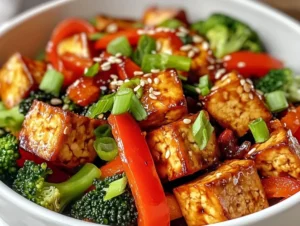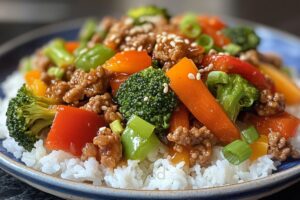Korean beef bowl is my go-to solution when I need dinner on the table fast without sacrificing flavor. This one-skillet wonder transforms simple ground beef into something absolutely delicious in just 25 minutes.
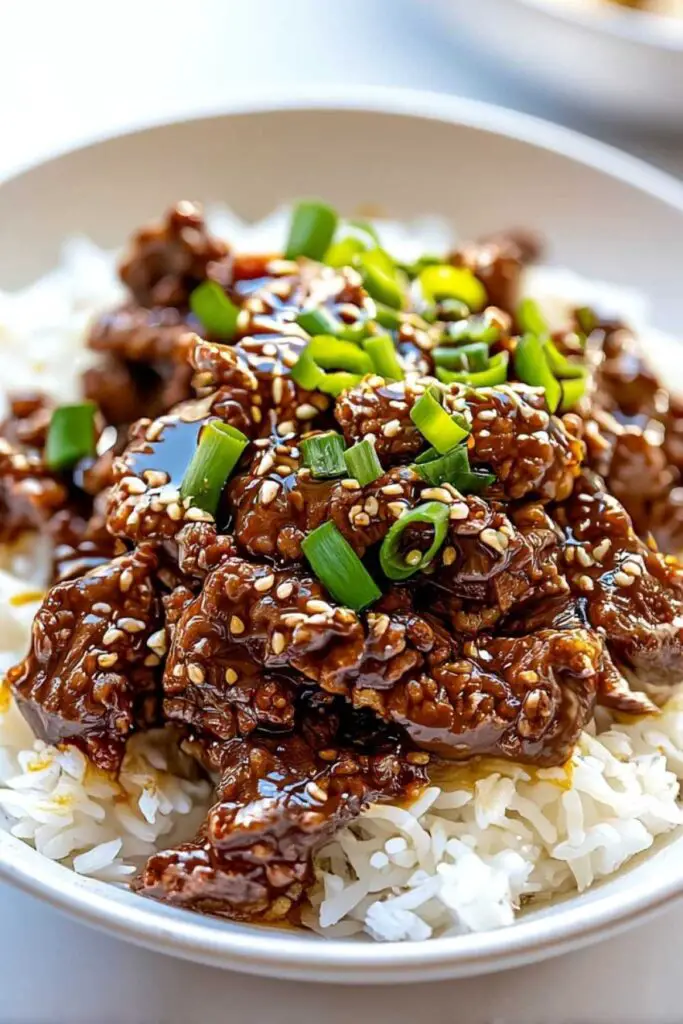
I’ll never forget the first time I made this dish on a particularly hectic Tuesday evening. My kids were cranky, homework was piling up, and I was staring at a pound of ground beef wondering what magic I could work. That’s when I remembered this Korean-inspired recipe that my neighbor had shared with me. The combination of soy sauce, brown sugar, and sesame oil creates this incredible savory-sweet sauce that had my whole family asking for seconds. What started as a desperate weeknight solution has become one of our most requested dinners, right alongside our slow cooker sloppy joes and other family favorites. The best part? Everything cooks in one skillet, which means minimal cleanup for this busy mom. This Korean beef bowl delivers bold, restaurant-quality flavors using ingredients you probably already have in your pantry. Let’s get cooking!
Why You’ll Love This Korean Beef Bowl
This Korean beef bowl has become a staple in my kitchen because it strikes that perfect balance between quick, healthy, and absolutely delicious. I’ve been making variations of this dish for over five years, and it never fails to satisfy my family’s craving for something flavorful yet comforting.
- Ready in just 25 minutes – perfect for those busy weeknights when time is short
- Uses simple pantry staples – no hunting for specialty ingredients at multiple stores
- One skillet meal – minimal cleanup means more time with your family
- Great for meal prep – makes excellent leftovers that taste even better the next day
- Bold, savory-sweet flavors – the sauce combination is absolutely irresistible
- Family-friendly – even picky eaters love this dish, and you can adjust the spice level easily
This Korean beef bowl is more than just a quick dinner—it’s become one of those recipes that brings everyone to the table with genuine excitement.
Ingredient Note List
Ground beef: I always recommend using 80/20 ground beef because it provides the perfect balance of flavor and tenderness—the same ratio I use for my crockpot sloppy joes.
Soy sauce: This forms the salty, umami base of our sauce and gives the dish its distinctive savory depth that makes Korean flavors so addictive.
Brown sugar: The sweetness balances the saltiness of the soy sauce perfectly, creating that signature sweet-savory combination that makes this dish so craveable.
Fresh garlic: I always use fresh minced garlic rather than powder because it adds a sharp, aromatic punch that really makes the flavors pop in your mouth.
Fresh ginger: Make sure to use freshly grated ginger for the best flavor—it adds a warm, slightly spicy note that’s essential to authentic Korean taste.
Sesame oil: Don’t skip this ingredient! Sesame oil provides a nutty richness that ties all the flavors together and gives the dish its authentic Korean character.
Red pepper flakes: These add just the right amount of heat and can be adjusted to your family’s spice preference—start with less if you have sensitive palates.
Cooked white rice: I prefer using day-old rice because it has a better texture and absorbs the delicious sauce without becoming mushy.
Green onions: The fresh, mild onion flavor and bright green color make the perfect finishing touch for both flavor and visual appeal.
Sesame seeds: A generous sprinkle adds a lovely nutty crunch that contrasts beautifully with the tender beef and soft rice.
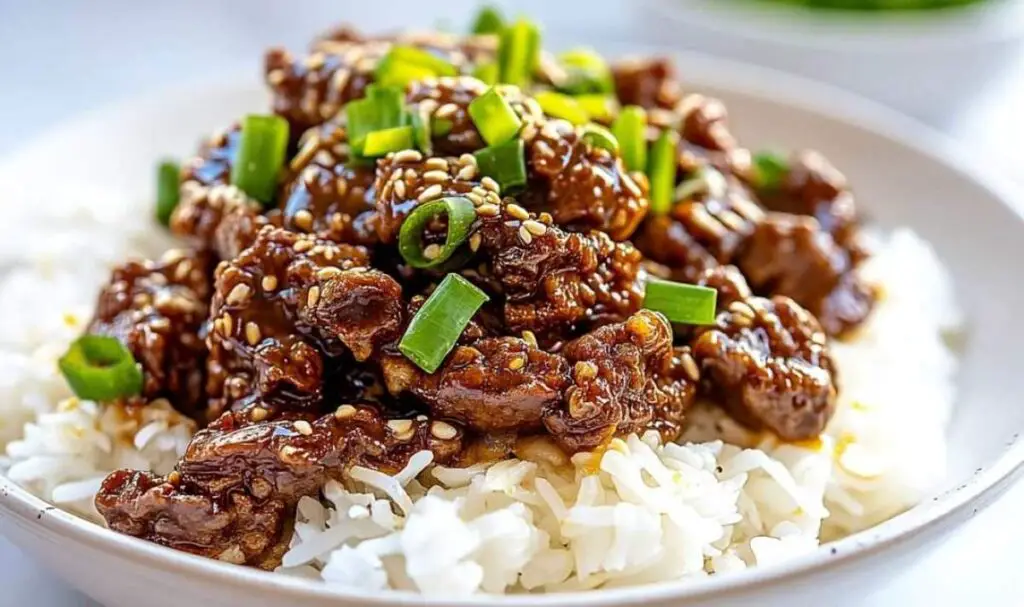
How to Cook Korean Beef Bowl
Step 1. I usually start by heating the sesame oil in my large skillet over medium heat—this creates a fragrant base and prevents the beef from sticking.
Step 2. Add the ground beef to the hot skillet and cook until nicely browned—using the same browning technique I share in my Mongolian noodles with ground beef recipe, breaking it apart with a wooden spoon as it cooks.
Step 3. While the beef browns, I whisk together the soy sauce, brown sugar, minced garlic, and grated ginger in a small bowl to create our flavorful sauce.
Step 4. Once the beef is fully cooked, I drain any excess fat from the skillet to prevent the dish from becoming greasy.
Step 5. Pour the prepared sauce over the beef and stir well—my family always gathers in the kitchen when they smell this amazing combination cooking.
Step 6. Let the beef simmer in the sauce for 3-4 minutes so it can absorb all those wonderful flavors and the sauce slightly thickens.
Step 7. I sprinkle in the red pepper flakes during the last minute of cooking and taste for seasoning—you can always add more to suit your heat preference.
Step 8. Serve the saucy beef over bowls of hot cooked rice, making sure to drizzle any extra sauce from the pan on top.
Step 9. Finally, garnish each bowl with sliced green onions and a generous sprinkle of sesame seeds before serving—this adds both flavor and that restaurant-quality presentation my family loves.
How to Store & Reheat
I usually store any leftover Korean beef bowl in an airtight container in the refrigerator, where it stays fresh and delicious for up to 4 days. Make sure the beef mixture cools completely before sealing to prevent condensation from making everything soggy.
For longer storage, this dish freezes beautifully for up to 3 months—just like my chicken marinade preparations that also meal prep wonderfully. I recommend portioning it into individual servings in freezer-safe containers—this makes it easy to grab a single serving for lunch or a quick dinner later.
When it comes to reheating, I’ve found the best method is in the microwave with a splash of water to keep the beef moist. Heat in 30-second intervals, stirring between each, until heated through. You can also reheat it in a skillet over medium-low heat, adding a tablespoon of water if needed to loosen the sauce.
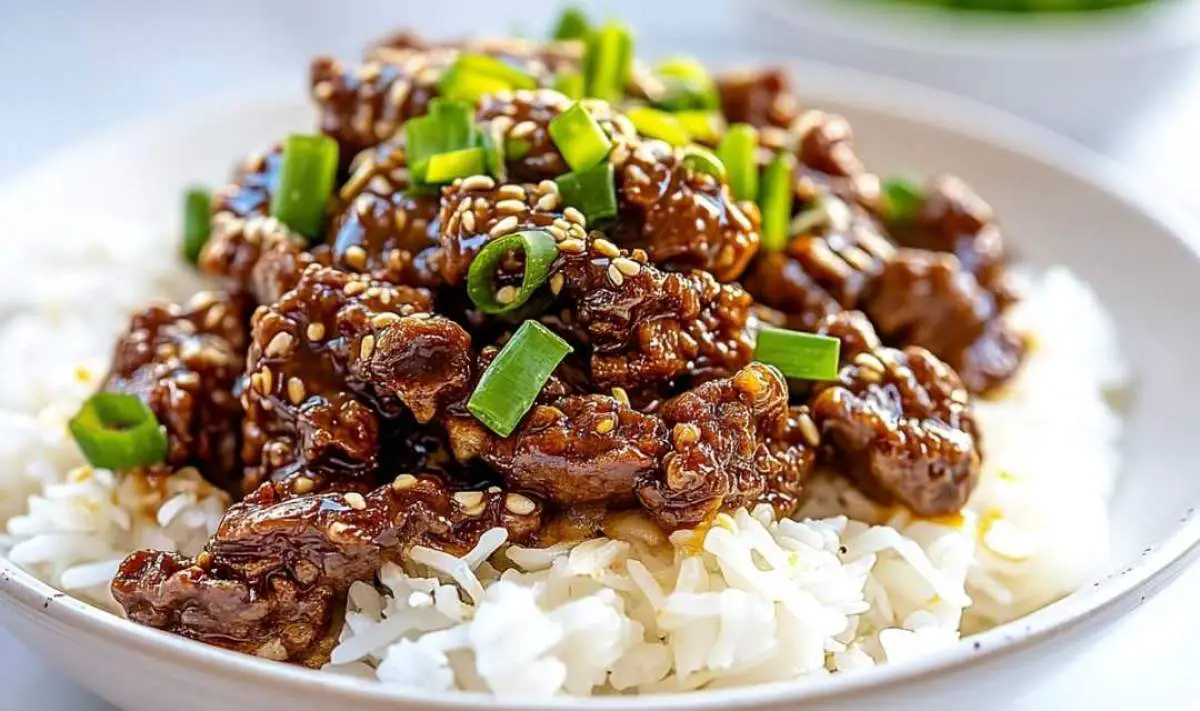
Korean Beef Bowl
Ingredients
Equipment
Method
- Heat sesame oil in a large skillet over medium heat. Add ground beef and cook, breaking it apart, until browned (about 5–7 minutes).
- Drain excess fat from beef. Pour sauce into skillet and stir. Let simmer 2–3 minutes so beef absorbs the flavors.
- Sprinkle in red pepper flakes. Stir and adjust seasoning to taste.
- Spoon hot rice into serving bowls. Top with saucy beef.
- Add green onions and sesame seeds over each bowl before serving.
Notes
What to Serve with Korean Beef Bowl
Din Tai Fung Cucumber Salad: A simple cucumber salad with rice vinegar dressing provides a refreshing, cooling contrast to the warm, hearty nature of this dish.
Teriyaki Shrimp Stir Fry: Adding another protein creates a more substantial meal, and the teriyaki flavors complement the Korean-inspired sauce beautifully.
Steak and Shrimp Stir Fry: For those wanting an extra-hearty dinner, this protein-packed stir fry pairs wonderfully with the Korean beef bowl flavors.
Roasted Vegetables: The natural sweetness of roasted carrots or broccoli enhances the brown sugar notes in the Korean beef while adding beautiful color to your plate.
Hidden Valley Ranch Dip: Perfect for serving with fresh vegetables on the side, this creamy dip balances the bold Asian flavors.
Fried Egg: My family’s favorite addition—a sunny-side-up egg on top turns this Korean beef bowl into an even more satisfying and protein-rich meal.
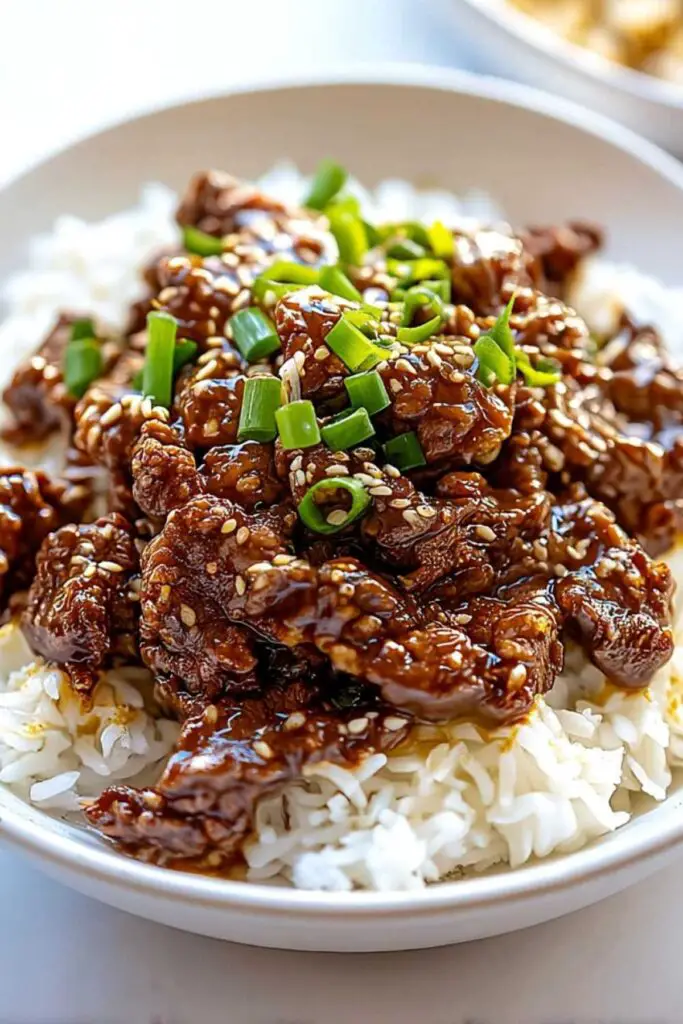
FAQs
Can I use ground turkey instead of beef in this Korean beef bowl? Absolutely! I often substitute ground turkey when I want a leaner option—similar to how I modify the protein in my Greek yogurt chicken for healthier meals, just make sure to add a little extra sesame oil since turkey can be drier than beef.
How can I make this Korean beef bowl spicier? I recommend adding gochujang (Korean chili paste) for authentic heat and flavor, or simply increase the red pepper flakes to your taste preference—start small and add more as needed.
Is this Korean beef bowl healthy for regular meals? Yes, this dish provides 25 grams of protein per serving and when served with vegetables, it makes a well-balanced meal that fits into most healthy eating plans.
What’s the best rice to use for Korean beef bowl? I prefer using jasmine or medium-grain white rice because they absorb the delicious sauce perfectly, but brown rice or cauliflower rice work great for healthier alternatives.


